Alim D. Tytar, Marina G. Podoprigora, Irina A. Nazvanova
Department of management, Southern Federal University
Correspondence to: Irina A. Nazvanova, Department of management, Southern Federal University.
| Email: |  |
Copyright © 2012 Scientific & Academic Publishing. All Rights Reserved.
Abstract
Manager’s professionalism reveals itself in taken decisions, correct goal-directed behavior, and high job performance. Sometimes successful goal-directed behavior is hindered by inner restrictions and contradictions that are the result of conflicting concepts within human consciousness: ideas, beliefs, values or emotional reactions reinforced by stress situations. So, a successful manager is going to be the one who applies a correct (adequate, appropriate) behavioral, emotional, or cognitive coping strategy under the circumstances. The ability to choose and to use the right strategy depends on a manager’s personality. This paper focuses on the study of pictopolygraphy as a method of assessment and prediction of managers’ abilities to perform effectively in a difficult situation.
Keywords:
Pictopolygraph method, Managers’ personality traits, Coping behavior, In stress situations
Cite this paper: Alim D. Tytar, Marina G. Podoprigora, Irina A. Nazvanova, Pictopolygraphy as a Method of Future Managers’ Personality Assessment, Management, Vol. 3 No. 7A, 2013, pp. 8-15. doi: 10.5923/s.mm.201310.02.
1. Introduction
Personality traits of a manager determining his behavior, decision – making and decision implementing abilities let him finally become successful in the performance of his job. So far, there is neither clear understanding of the traits the personality of an effective manager should possess nor criterion of such traits evaluation. Thus, in opinion of P. Drucker (2004)[1], the basic skills of effective manager are, first of all, ability for personal development and respect for an individual. The truth of the latter statement is obvious. Only a self-aware person can develop his strengths and eliminate weak points as well as persistently organize his behavior for better pursuing his own and organizational goals. From experience of some efficiently-run US companies, striking results in people management can be achieved by charismatic leaders who are able to arouse people’s emotions (Thomas J. Peters and Robert Waterman Jn., 2005)[2] and sufficiently use communicational and interpersonal skills (Morehouse R., 1997)[3]. This idea is supported by D. Maister. Moreover, he presumes that it is possible to become an effective manager treating people as your equal, as professionals, caring about self-realization through achievements of your employees (Maister D., 2006).[4]Woodcock, M. and Francis, D. (1991), the authors of limitation concept, outline 11 abilities necessary for every manager and crucial for professional success. They are: self-control ability, reasonable personal values, definite personal goals, focus on continuous personal development, problem-solving skills, inventiveness and capacity for innovation, high-level ability to influence other people, notion of modern managerial approaches, leadership ability, ability to train and develop employees, and ability to form and develop high proficiency working groups.[5] Furthermore, in our opinion, it is not by coincidence that self-control ability or, in other words, emotional balance and ability to handle stress (Parkinson S. Northcott, Rustomji М. К., 1992)[6], comes first on the list. In our unstable world, where stress and uncertainty become everyday phenomena, it is really important to learn not to waste stamina and health but, on the contrary, to mobilize efforts to achieve the intended target by adapting to the current situation. This determines the professionalism of a manager. It should be noted that researchers demonstrate a certain interest to the issues related to active, goal directed behavior determined by problem and crisis situations. At the same time, “Such research is carried out within the framework of cognitive-behavioral model of stress management behavior – coping» (2008)[7, р.4]. “Coping” may be defined as interaction between the personality and the stressful or crisis situation (Lazarus R.S., 1966)[8]. In general, we differentiate between adaptive and maladaptive coping strategies, which are understood as peculiar to a human being model of behavior in an unusual situation. Analysis of coping strategies of management students may help to reveal and when it is necessary, to correct key parameters of effective behavior of manager - emotional balance, motivation, self-organization, etc.Here we rely on cognitive – affective theory of Walter Mischel (1973)[9]. The theory analyzes behavior shaping mechanism through interaction of cognitive-affective units and situational variables. The main cognitive-affective units are comprised of competencies and self-regulatory strategies (this is what a person can do and his strategies of performing his acts), coding strategy (method of comprehension and categorization of information), anticipation and warning of possible behavioral consequences, as well as goals, values, and emotional reactions (Mischel W., 1995)[10]. Thus, the paper considers probability to predict effective behavior of a manager in complex working environment on a basis of pictopolygraph method. To research stressful situations behavior strategies, we used pictopolygraphic equipment manufactured by scientific and production engineering firm “Medicom MTD” («Медиком МТД»), Taganrog, Russia.[11]According to the above, the following hypotheses have been built:1. There is a correlation between practical working experience in management and typical personal patterns of coping behavior.2. Using only verbal tests and surveys to study the coping peculiarities as a personal trait of a manager is not enough due to their inability to gain a complete objectification of results and arising need for more detailed research in real situation.3. Implementation of pictopolygraph method provides more accurate and complete information, saves time, and provides the possibility to develop an individual program aimed at correcting ineffective behavioral reactions of managers.
2. Method
2.1. The Method Description and Analysis
Pictopolygraph method unites and renews well-known psychological and psychophysiological research methods by integrating emotion rating scale into them. The scale helps to objectively differentiate personal value of stimulus according to the degree of consistency and force of reactions belonging to different physiological and pictographic signals, simultaneously registered in the process of experimental micro-modeling human activity. The method is based on joint analysis of the trends of physiological data and behavioral activity parameters while a subject accomplishes specific tasks of diagnostic scenarios with special stylus on an electronic graphic pad. (2007).[11; 12; 13; 14; 15; 16; 17]Tasks for diagnostic scenarios are grouped according to sense clusters. Allocation of tasks over time, averaging, specification, and sorting of integral indicators according to those sense clusters help to represent results in the form of “sense and emotional significance profiles”. (fig.1).  | Figure 1. A fragment of test’s profile «Coping behavior in stressful situations» |
For interpretation of a sense and emotional significance profile, we take into account two main parameters – the “bar magnitude” and “reactions dispersion”, which are indicated by the horizontal (fig.2). During interpretation process, the correlation of these two parameters is basic for a researcher. 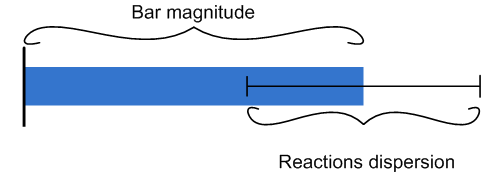 | Figure 2. Graphic representation of reaction force (M) and reactions dispersion (m) |
So, bar magnitude depicts «reaction force» (М) of a testee to the stimulus. In mathematical terms, this is a graphic and numeric representation of reaction average magnitude in one of X, Y or Z vectors or the integrated score in XYZ totality of the three vectors (Tytar A.D., Tytar E.T., Yershov V.I., 2009)[18], where:Vector X – is a vector of nominally uncontrolled values on the basis of electroencephalograph signals. It may be interpreted as a cognitive element of “I think” reaction.Vector Y – is a vector of nominally semi-controlled values on the basis of polygraphic signals of galvanic skin reaction, breathing, etc. It represents emotional “I feel” reaction.Vector Z – is a vector of nominally controlled values on the basis of movement of electronic stylus on a pad, degree of pressure on a stylus while drawing or writing, time of delay from the beginning of the experiment till the beginning of drawing, and the time of delay from completion of drawing till proceeding to the next stage. It represents motor reaction and may be interpreted as “I do”.Another parameter – «Reactions dispersion» (m) – represents the dispersion of reactions to the offered stimuli. In mathematical terms, this is an average error of average value, dispersion (without regard to statistics formula) (Tytar A.D., Tytar E.T., 2009)[19]. The mark that shows arithmetic average – reaction force – indicates the direction of reaction – left-side or right-side. That is, the direction of reaction to the vertical axis in coordinate system of these three vectors may point out the following:1) avoidance behavior (left-side reaction);2) achievement and acceptance (right-side direction);3) irregular reaction or absence of reaction to the stimulus demonstrate irrelevance at the moment of testing (slight diversions from the axis) (Tulynina A., 2009)[20] .It ought to be noted that left-side reaction most often occurs when a testee “accepts” the response to the question and in self-reflection singles out the fact of consistency of “feelings” and “thoughts” in relation to the “issue under inquire”; he does not have inner “struggle” for the right choice. Though it is not always apparently obvious, experience has proven that when a testee is given a practical example, the above statement proves to be true (testee easily calls to mind real life situations). Left-side reaction corresponds to “non-acceptance”, “struggle”, and “discrepancy between desired and actual” reaction, a kind of a “choice of the right answer conflict. During self-reflection, a testee may experience some difficulty in the choice of real-life situation example, or it appears that he does not have any examples at all. It is usually connected with a desire of a testee to show himself better than he really is, to find a socially desirable image. Also, it represents the presence of an inflated self-concept in a testee, or tested personal qualities have not been revealed yet. Thus, physiopictopolygraphic reactions show consequent “response” first of all through general direction of reaction. This category of interpretation requires further investigation and may be applied by each researcher individually.During the analysis of the material, the intensity of reaction ought to be estimated: distinct reaction, moderate reaction, and mild reaction. If there are distinct reactions in XYZ integrated score, then it is possible to interpret the formation of each vector separately. This choice is made by a researcher on the basis of the obtained analysis data.A distinct reaction is called a high force reaction with dispersion not more than 25% of its force (m/M). Moderate reaction – is a high force or moderate reaction in comparison with the others and with dispersion in the range of 25% – 55% of its force (m/M).Mild reaction (less important to testee, unformed) – is a less intensive reaction (bar magnitude) with a greater dispersion – more than 50% of reaction force (m/M).If we take into account the category of “accuracy of reaction”, the category of “stability / instability” will appear in the interpretation of the reaction. Stable reaction will be the one that is valid in spite of its force. For example, a reaction of mild force ("valid"), but with a small dispersion may indicate that the research subject is not relevant in the period of testing (it seems to be "asleep"), but still there is a stable view of it (in the reactions of the testee).Validity appears in an interpretation when we talk about the stability (typicality) of reaction to a presented stimulus. The smaller the reactions’ dispersion is, the greater will be the validity value. It is possible to assert they are of the same type and that is why less volatile. In terms of interpretation, this could indicate the “stability” of reaction during a certain period of time, until something can change reactions to the presented stimulus. And it is not always so when a highly intensive reaction has a validity value.The force of reaction shows whether a testee gives a certain or an uncertain answer, and a small dispersion (m) shows that a testee feels confident in his answers while greater dispersion (m) of reactions shows uncertainty of the answer. Force indicator (as we may suppose) determines the importance, significance of the topic to a testee (at the time of testing), and the dispersion of reactions - the degree of stability in relation to this topic.From above said, we may conclude that testing with the pictopolygraphic equipment may detect even unconscious attitude to the tested areas. Assessment of unconscious predicate data is particularly important because they manifest both the true motivation and the true relation to all declared aspects of the investigated area. This becomes very clear during complex analysis of verbal testing results and their psychophysiological correlates.In individual’s psychological space at a certain moment of time, there are various factors with different degree of importance, and among them we can single out:1) unconsciously ignored moments, the cause of which may be, for example, irrelevance or incapability to achieve the goal etc.;2) sensitive tense areas;3) harmonious spheres that are apparently a kind of reference points for an individual’s self-actualization. All of these areas have their own characteristics according to the results of not only verbal tests but also of pictopolygraphic analysis.Hence, it follows that personality’s psychological space is more volumetric and ambiguous than it could be demonstrated only by the analysis results of verbal tests..
2.2. Participants
From 2011 till 2013, 70 management students and 25 managers of different levels and from various enterprises of Rostov Region (Russia) participated in the research.
3. Results
For diagnosis of behavioral activity strategies in stressful situations, we used "Coping behavior in stressful situations" technique (S. Norman, D. Endler, D. James, M. Parker, an adapted version by T. Kryukova) [21; 22] in a pictopolygraphic form. For illustrative purposes, we are going to draw two examples of testing. One of the testees (Bv) has no experience in management, another (Кn) – has been working as a group leader for 5 years.In 3а, 3b, 3c, 3d figures the results of Bv testee are represented. According to the results of recorded sense and emotional reactions experienced in the process of answering questions related to the behavior orientation in stressful situations, we can observe a true right-sided force of reaction directed to avoidance on the orientation scale. According to sense and emotional reactions while answering the questions on strategy types in stressful situation (fig. 3d), we record both true left-side reaction to adaptive coping strategies and right-side reaction to maladaptive ones. Moreover, a true left-side reaction was detected on Y-scale (i.е. on scale of emotional response in stressful situations).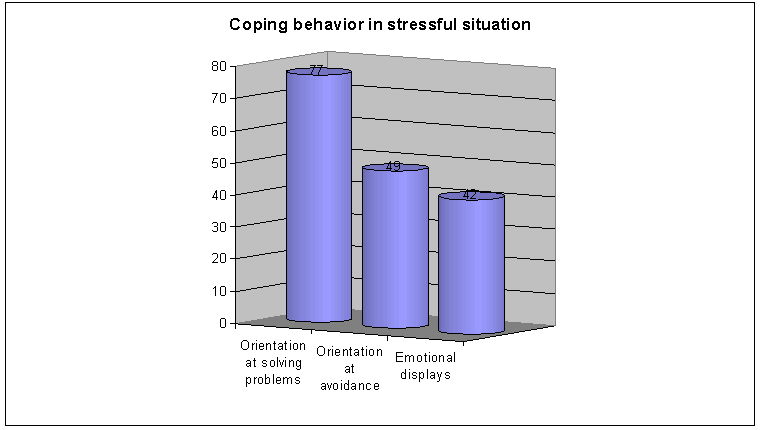 | Figure 3а. The result of verbal answers to the questions on orientation of behavior in stressful situations |
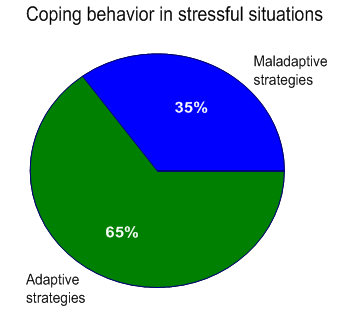 | Figure 3b. The result of verbal answers to the questions on type of strategies in stressful situations |
Thus, as for this testee, we may assume that his emotional reactions are of disorganizing character in stress situations and he will be oriented at avoidance of such situations. According to the obtained data, Bv testee should be recommended to undergo a supplementary testing to reveal personality factors causing such results, and in case of necessity to retain this employee in staff, he should also be recommended to receive emotional stability training.According to the results of the verbal answers (Figure 3a), the testee in his opinion is oriented 61% to problem solving and 39% to the avoidance of difficult situations. At the same time, 65% of his behavior corresponds to adaptive strategies (Fig. 3b). | Figure 3c. Sense and emotional reactions while answering questions on orientation of behavior in stressful situation |
 | Figure 3d. Sense and emotional reactions while answering questions on strategy types in stressful situation |
4а, 4b, 4c, 4d figures represent testing results of working manager’s coping behavior (Kn).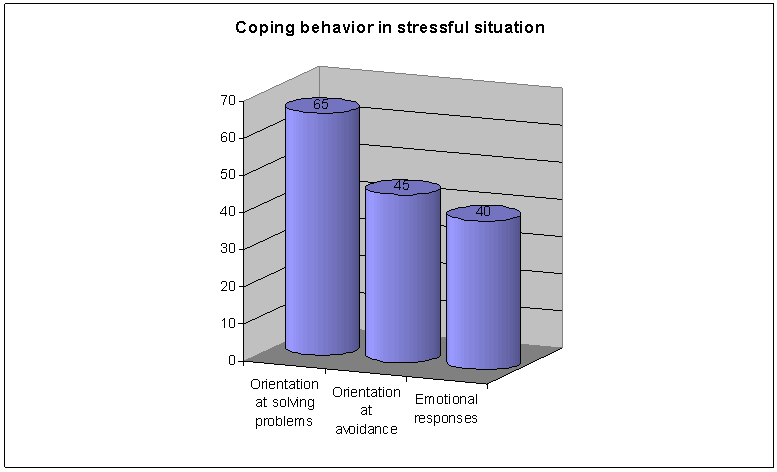 | Figure 4а. The result of verbal answers to the questions on orientation of behavior in stressful situation |
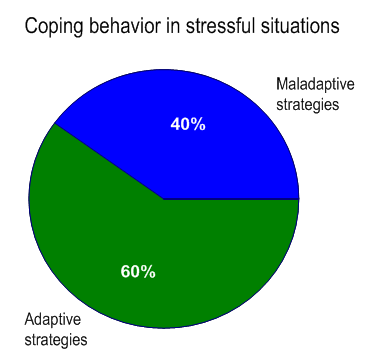 | Figure 4b. The result of verbal answers to the questions on strategy types in stressful situation |
According to the results of verbal answers (рис. 4-а), the testee in his opinion is 57% oriented to problem- solving and 43% to avoidance of challenging situations. Moreover, 60% of his behavior corresponds with the adaptive strategies.(fig. 4b).  | Figure 4c. Sense and emotional reactions while answering the questions on orientation of behavior in stressful situation |
 | Figure 4d. Sense and emotional reactions while answering the questions on strategy types in stressful situation |
According to the recorded sense and emotional reactions during behavior orientation testing (fig. 4c), we can see on orientation scale both a true left-side reaction force directed to avoidance and a true right-side reaction force oriented at problem – solving. Analysis of sense and emotional reactions of the testee while answering the questions on strategy types in stressful situation (fig. 4d) demonstrates a true right-side reaction to adaptive coping-strategies and right-side reaction to maladaptive coping strategies. It should be noted that right-side reactions in the first case are presented on X and Y scale and in the second - on X axis. Thus, it may be assumed that in stress situations despite notable assessment of his emotional reactions in X axis (fig. 4c), the prevailing behavior for Kn will be orientation at problem-solving. In connection therewith, the testee may be recommended to receive self-assertion and emotional stability trainings.Thus, having considered the above examples, one may conclude that focus on verbal answers in questionnaires and disregard of sense and emotional reactions may lead to the loss of highly proficient employees, while in-time correction of their abilities and self-concept will ensure their adaptive behavior and let them increase proficiency.
3.1. Discussion
On the basis of the conducted research, we drew the following conclusions.Most testees with working experience apply maladaptive coping behavior strategies. However, in contrast to the managers without working experience, they also demonstrate more adequate assessment of their behavior particulars in challenging situations. This can be explained by the fact that management students have not faced stressful factors at work yet and their opinion is supported only by what they think they would do in a certain situation; however, the confirmation of the last statement requires a separate research.Issues related to study of other personality traits and situational factors influencing mode of behavior not only in stress, conflict situations but also in everyday work routine, require special research as well. Thus, present research proved the hypothesis of getting reliable and complete data on personality traits by implementation of pictopolygraph method. Moreover, the results gained due to this method may be useful in the process of building individual program of correction of managers’ ineffective behavioral reactions. The results may be of particular interest already in the training process of management students in college or in the process of individual’s adaption in the organization.In general, it should be noted that further inquiry of pictopolygraph method usage for testing manager’s personality traits could be useful both from practical and theoretical points of view.Theoretical value of similar researches may consist in the extension of knowledge of prospects of human behavior management by means of effecting some definite cognitive-affective units and situational variables, including stressful factors.From practical point of view, research results may be useful for human resources management. Thus, after pictopolygraphic testing appears possibility to inquire into not only an individual’s past, but also into his plans for the future; as well as it significantly increases the capabilities of top managers for personnel selection, personnel monitoring, and control of employee’s loyalty. Such testing also helps to reveal hidden health problems, various types of addictions; it is also useful for the prevention of malfeasance.
References
| [1] | Drucker P. The Effective Manager. Publishing house: Book Chamber International, 2004. – 268p. |
| [2] | Thomas J. Peters and Robert Waterman Jn., In Search Of Perfection. Lessons of the most efficiently-run US companies "Publishing House" Williams ", St. Petersburg, 2005 - 560 p. |
| [3] | Morehouse R. Three keys to becoming a leader // Emerald Management Reviews. - Nov 1997, Volume: 42 Issue: 11 pp.53-55. |
| [4] | Maister D. First Among Equals: How to Manage a Group of Professionals/ David Maister, Patrick McKenna; trans. from English. by M.S. Ivanov and M.V. Ferber. - M.: Mann, Ivanov and Ferber, 2006. - 336 p. |
| [5] | Woodcock М., Francis D. The unblocked manager. A practical guide to self development. – М.: Delo, 1991. – 320 p. |
| [6] | C. Northcote Parkinson, Rustomji М. К. Excellence in management / Translation from English by N.I. Gorskaya and E.N. Mamontova. - St. Petersburg. "Lenizdat", 1992. 143 p. |
| [7] | Methods of psychological diagnostics of coping behavior in stressful and challenging situations. Manual for physicians and medical psychologists. - St. Petersburg.: NIPNI n.a. V.M. Bekhterev, 2008. - 37 p. |
| [8] | Lazarus R.S. Psychological stress and the coping process. New York: McGraw-Hill, 1966. |
| [9] | Mischel W. Toward a cognitive social learning reconceptualization of personality. Psychological Review, 80. – 1973. рр. 252-283. |
| [10] | Mischel W. & Shoda Y. A cognitive-affective system theory of personality: Reconceptualizing situations, dispositions, dynamics, and invariance in personality structure. Psychological Review, 102. – 1995. рр. 246-268. |
| [11] | The official web-site of scientific and production engineering firm “Medicom MTD” (Taganrog, Russia)// URL:http://www.medicom-mtd.com/ |
| [12] | Objective psychological analysis and “Egoscope” testing User's Manual. - Taganrog scientific and production engineering firm "Medicom MTD", 2007. – 110p. |
| [13] | Egoscope application // Best of Security. № 2. – 2007. – Pages 72-74. |
| [14] | Kasian S.V. EGOSCOPIA (fundamentally new method of synchronous diagnosis during the assessment and selection of proficiency staff // Best of Security. – №12. 2006. URL: http://www.bos.dn.ua |
| [15] | Yuriev G.P., Skomorokhov А.А. Egoscope application // Best of Security. – № 3. – 2007. – Pages 82-84 |
| [16] | Objective psychological analysis and “Egoscope” testing. User's Manual. Scientific and production engineering firm “Medicom MTD” - Taganrog, Russia, 26.10.2007 |
| [17] | Objective psychological analysis and “Egoscope” testing. User's Manual. Scientific and production engineering firm “Medicom MTD” - Taganrog, Russia, 04.03.2008 |
| [18] | Tytar A.D., Tytar E.T., Yershov V.I. Pictograph method for detection of intentional psychological characteristics of a manager. Proceedings of the International Conference on 21-24 September 2009, Volgograd, Russia. P. 46. |
| [19] | Tytar A.D., Tytar E.T. Egoscopy in competencies building approach to the academic process. Proceedings of SFedU. Engineering sciences. Special Issue "Perspectives of medical equipment." - Taganrog: TIT of SFedU Publishing House 2009. - 10 (99). - P. 253-254. |
| [20] | Tulynina A. Yu. The study of the sensitivity of indicators of the test method “Style of self-regulation of behavior” during the pictopolygraph research (Paper). Proceedings of SFedU. Engineering sciences. Special Issue "Prospects of medical equipment." - Taganrog: TIT of SFedU Publishing House 2009. - 9 (98). – P. 176 - 181. |
| [21] | "Coping behavior in stressful situations" technique (S. Norman, D. Endler, D. James, M. Parker, an adapted version by T. Kryukova) / Fetiskin N.P., V.V. Kozlov, G.M. Manuilov Socio-psychological diagnosis of personality development and small groups. - Moscow, Publishing House of the Institute of Psychotherapy. 2002. Pages 442-444. |
| [22] | Kryukova T. L. Psychology of coping behavior in different stages of life: Doctoral dissertation. Kostroma, 2006. 473 pages. |











 Abstract
Abstract Reference
Reference Full-Text PDF
Full-Text PDF Full-text HTML
Full-text HTML